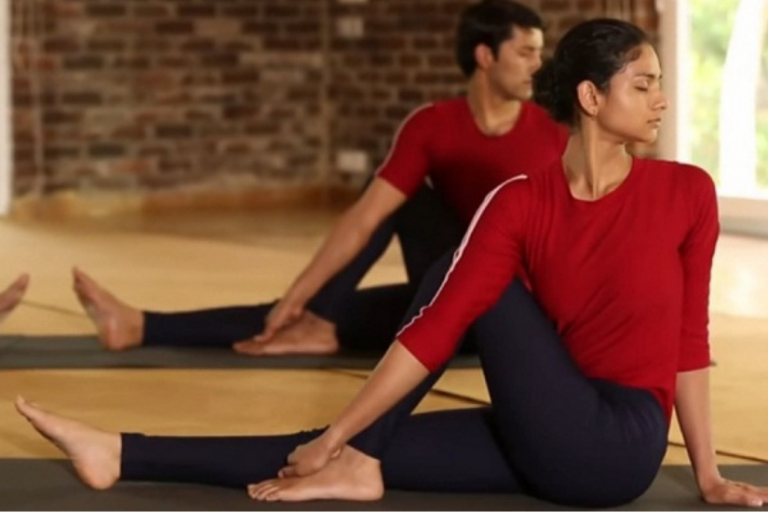Yoga benefits people of all ages in different ways. Practicing Yoga, generally, has a positive impact on your body, mind, and how you function in your everyday lives. It improves your flexibility, boosts immunity and metabolism, helps you lose weight, and lowers your stress level. Yoga is an effective tool for reducing high blood sugar, improving your blood circulation, and flattening the obesity curves on your body. According to research, performing Yoga regularly helps in managing diabetes. With so much awareness about Yoga and its immense benefits, let us specifically discuss an effective Yoga asana called Vakrasana.
A simplified form of Ardha Matsyendrasana, Vakrasana, is also called a Half Spinal Twist. Those who cannot perform Ardhamatsyendrasana are often prescribed Vakrasana. But very often, by practicing Vakrasana, the Ardha Matsyendrasana posture is achieved. Performing this half-spinal twist pose is very useful for the toning of spinal nerves, organs, and abdominal muscles. It cures and minimizes the effect of many disorders and diseases.
What Are The Steps To Practice Vakrasana?
Vakrasana is a simple and easy asana performed by giving the spinal column a half torsion or twist. In the classical pose, the Vakrasana is performed with the following steps.
1. Sit on the mat, stretch your legs fully forward, put your toes together so they point upwards, and keep your hands beside the body, with your palms resting on the mat.
2. It is of utmost importance to keep your back straight in line with your neck and head, chin tucked in, and aligned with the ground.
3. Stretch both your hands forward to raise them to the level of your shoulder, with your palms facing downward, maintaining a ‘shoulder width’ distance between them. Breathe normally.
4. Swing your hands slowly towards your right, twisting the spine.
5. Move your neck, hands, and shoulders in sync. Fix your gaze on the right thumb.
6. Align your hands parallelly with each other and keep your feet straight.
7. Ensure smooth movements without leaning backward while twisting. Do not move.
8. Align your hands and feet parallel to each other.
9. Ensure smooth movements and try not to lean back while twisting.
10. Inhale within 3 seconds, get back to the starting position, exhale and shift the gaze to the left thumb.
11. Repeat the above mentioned steps on the left side to complete the first round.
Points You Must Remember While Practicing Vakrasana
- While practicing Vakrasana, keep the motion in the back region minimal. It will aid you in practicing Vakrasana in an effective way and help you derive the maximum benefits.
- While practicing Vakrasana, ensure that you do not strain your spine. If you perform the asana correctly, only then will you be able to derive the maximum benefits.
- When practicing Vakrasana, ensure that your shoulders are at the same level.
- When practicing Vakrasana, always pay attention to your body posture and keep your back straight.

Precautions While Performing Vakrasana
While Vakrasana has its own set of benefits, you must consult the doctor before getting started with it or any asana. It is advisable not to practice Vakrasana if you are suffering from the following medical conditions –
- Spinal injury
- Hernia
- Back pain
- Peptic ulcers
- Hyperthyroidism
- Brain or Heart problem
- Sciatica or slipped discs
- Do not perform Vakrasana after 2-3 months of pregnancy
- Knee pain
- Abdominal region surgery
- If you suffer from a stiff spine, then it is better to practice Vakrasana steps under the supervision of a yoga expert.

Benefits of Vakrasana
- When you practice Vakrasana, it benefits your spine and nerves at the back. Practicing this asana along with Ashtanga Yoga. provides extension and compression to your back, spine muscles, and nerves. It improves the condition of your back, spine, muscles, and nerves.
- When you practice Vakrasana, it benefits your lungs. It helps the body squeeze out the stagnated blood from your spinal region. This helps to circulate that blood to the lungs and heart for the purpose of purification, thereby improving the health of your lungs.
- Vakrasana supports older people to prevent adjoining vertebrae from fusing, thereby preventing a common health issue among older people.
- Vakrasana treats health issues such as backache, neck ache, and headache.
- Vakrasana increases the flexibility of your body and reduces stiffness. Those who have issues related to body stiffness must practice Vakrasana.
- Performing Vakrasana is exceptionally beneficial for those who have diabetes. When you perform Vakrasana, it massages your abdominal organs and stimulates your pancreas.
- Vakrasana also treats other health problems such as rheumatism and constipation. It is especially true for those who have to manage diabetes on a daily basis.
- When you practice Vakrasana, it stimulates and instructs the beta cells of the pancreas. It produces more insulin. The secretion of sugar in the blood controls diabetes. It strengthens the pancreas and pancreatic functions.
- Vakrasana is beneficial for those suffering from mild cases of sciatica and slipped disc.
- Those who are undergoing stress and strain in the back can benefit from Vakrasana. Those who suffer from pain while performing backward and forward Yoga asana must perform Vakrasana. It helps reduce the pain and promote flexibility.
- Vakrasana cures headaches as it circulates blood to different organs of the body, including the brain, and thereby helps you get rid of headaches.
- Performing Vakrasana helps to twist and compress the organs involved in the digestive system. The twist propels the digestive system to release more digestive juices and enzymes, enhancing and improving digestion. It synchronizes and adjusts the secretion of digestive juices and enzymes that are useful for treating digestive disorders and anomalies.
- Vakrasana promotes the health of the urinary region and prevents urinary infections from taking place. This asana promotes the proper blood flow, nutrients, and oxygen supply to the urinary area.
- Your back, spine, arms, abdomen, and shoulders are some of the apparent body parts that benefit from the Vakrasana.
- Vakrasana stretches the muscles of your entire body. It helps to eliminate chronic back and shoulder pain.
- Vakrasana helps to increase the elasticity of the spine and tones your spinal nerves.
- It massages your abdominal organs. It is suitable for the liver. It helps in reducing belly fat on the lateral side of the abdomen. It tones all the organs in the abdominal region. It helps remove the fat and flab around the waist area.
- It loosens your hip joints and relieves stiffness. Vakrasana exercises the abdominal and back muscles. It strengthens the powers of the lower back area, reduces back stiffness, and alleviates pain.
- Performing Vakrasana stimulates the Navel or the Manipur Chakra while keeping the Kundalini Shakti sublimated.
- The benefits of Vakrasana are similar to that of Ardha Matsyendrasana. It gives your spine a good twist and makes your spine flexible. The asana improves and facilitates the functioning of the adrenal glands.
- Vakrasana increases the circulation of blood in the pelvic region, including the supply of nutrients and oxygen. It keeps the female reproductive system in good shape and ensures optimal health.
Even though Vakrasana is easy to practice, you might find it extremely challenging to place the hand on the other side of the knee, as most of us do. If that is the case, then you can place the hand on the knee itself or keep it wherever it can be comfortably placed.
Key Takeaways
Vakrasana requires flexibility from the person performing it. It needs the back to be passive while practicing this asana to achieve the maximum benefits. It is essential for the person performing it to hold on to a final upright position. With all these factors in mind, one can extract the maximum benefits from the asana and better spine health. This asana is quite beneficial for those who suffer from anorexia, cervical problems, indigestion, menstrual disorder, spondylosis, diabetes, constipation, pancreatic dysfunction, and more. Next time you plan to practice Vakrasana, you must ensure that you do it correctly, take the appropriate precautions, and extract the optimum benefits.






